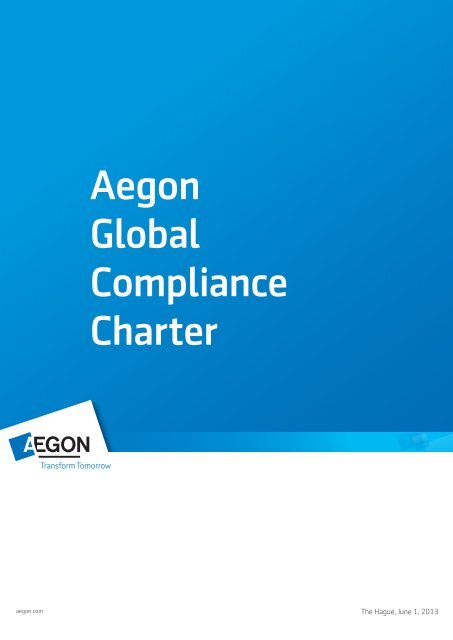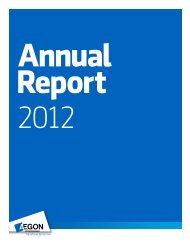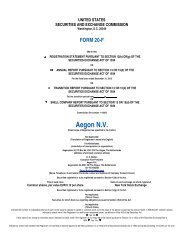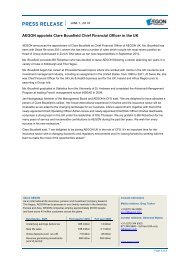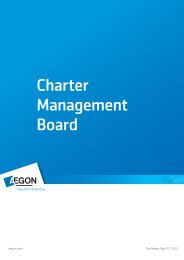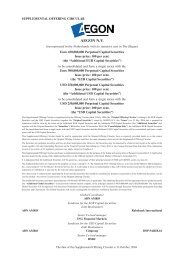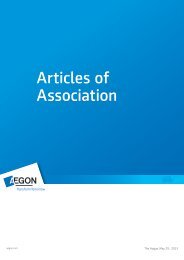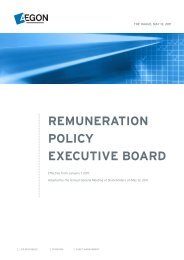Global Compliance Charter - Aegon
Global Compliance Charter - Aegon
Global Compliance Charter - Aegon
You also want an ePaper? Increase the reach of your titles
YUMPU automatically turns print PDFs into web optimized ePapers that Google loves.
<strong>Aegon</strong><br />
<strong>Global</strong><br />
<strong>Compliance</strong><br />
GLOBAL<br />
<strong>Charter</strong><br />
COMPLIANCE<br />
CHARTER<br />
aegon.com<br />
The Hague, June 1, 2013
Information sheet<br />
Target audience:<br />
All employees and management of <strong>Aegon</strong> companies<br />
Issued by:<br />
<strong>Aegon</strong> N.V. Group Risk<br />
Approved by:<br />
<strong>Aegon</strong> N.V. Management Board<br />
For further information:<br />
Group <strong>Compliance</strong> Officer <strong>Aegon</strong> N.V.<br />
Group<strong>Compliance</strong>Officer@aegon.com<br />
+31-70 344 8218<br />
Version/replaced: 3.0<br />
Valid from: June 1, 2013<br />
2
Contents<br />
1. Introduction<br />
2. Mission and objective of the <strong>Compliance</strong> Function<br />
2.1 Mission<br />
2.2 Objective<br />
3. <strong>Compliance</strong> Risk Management<br />
3.1 <strong>Compliance</strong> risk<br />
3.2 <strong>Compliance</strong> risk appetite<br />
3.3 Tolerance<br />
3.4 Role of the compliance function<br />
4. <strong>Compliance</strong> governance<br />
4.1 Governance within the entire <strong>Aegon</strong> organization<br />
4.1.1 Responsibilities of business management<br />
4.1.2 Role of the local compliance function<br />
4.1.3 Role of the Executive Board and Management Board<br />
4.1.4 Role of the Supervisory Board<br />
4.2 Governance within the compliance function<br />
4.2.1 Independence of the compliance function<br />
4.2.2 Responsibilities on reporting for the compliance function<br />
4.2.3 Essential factors of the governance structure<br />
5. Scope of the <strong>Compliance</strong> Function<br />
6. Closing remarks<br />
Appendix<br />
A. <strong>Compliance</strong> Methodology<br />
B. Glossary<br />
C. Quarterly reporting requirements (see <strong>Aegon</strong> Group <strong>Compliance</strong> Quarterly<br />
Reporting Requirements rev 002 050907)<br />
3
1. Introduction<br />
This document represents <strong>Aegon</strong>’s <strong>Global</strong> <strong>Compliance</strong> <strong>Charter</strong>. The <strong>Global</strong> <strong>Compliance</strong> <strong>Charter</strong> intends to strengthen the<br />
effectiveness of compliance within the <strong>Aegon</strong> group of companies 1 .<br />
<br />
The <strong>Global</strong> <strong>Compliance</strong> <strong>Charter</strong> describes the governance, roles and responsibilities, and operation of compliance<br />
management at <strong>Aegon</strong> group-wide. It defines the scope of the <strong>Compliance</strong> Function. The charter also sets forth<br />
the basic requirements of compliance management for <strong>Aegon</strong>’s businesses group-wide. The methodology of<br />
compliance risk management is described separately in Appendix A.<br />
<br />
The Executive Board and Management Board of <strong>Aegon</strong> N.V. approved and adopted this <strong>Global</strong> <strong>Compliance</strong> <strong>Charter</strong><br />
on April 13, 2010. It replaces the <strong>Aegon</strong> N.V. Group <strong>Compliance</strong> Guidelines dated November 21, 2005. The <strong>Charter</strong><br />
will be reviewed at least every two years and may be amended at any time with the approval of the Executive<br />
Board. It is available on the global <strong>Aegon</strong> intranet.<br />
<br />
Effective compliance management is vital for <strong>Aegon</strong>’s sustainable profitable growth. It is a very important<br />
contributor to the protection of <strong>Aegon</strong>'s integrity and reputation. It helps build trust. The <strong>Global</strong> <strong>Compliance</strong><br />
<strong>Charter</strong> supports <strong>Aegon</strong> in achieving its mission and strategic objectives.<br />
<br />
All capitalized terms used in this <strong>Charter</strong> have the meaning attributed to them in the glossary, which is attached<br />
as Appendix B.<br />
1 <strong>Aegon</strong> group of companies, also referred to as '<strong>Aegon</strong>' has the meaning set forth in Appendix B.<br />
4
2. Mission and objective of the <strong>Compliance</strong> Function<br />
2.1 Mission<br />
Being a global leader in helping customers to secure their financial future resulting in sustainable, profitable growth is key within<br />
<strong>Aegon</strong>. The mission of <strong>Aegon</strong>’s <strong>Compliance</strong> Function is to:<br />
a. Support <strong>Aegon</strong> and its management in achieving this principle by compliance management practices which contribute<br />
to sound and responsible business practices and integrity of the products and services delivered; and<br />
b. Support the business with incorporating this principle in the day-to-day operations of <strong>Aegon</strong> businesses worldwide.<br />
By pursuing this mission, the <strong>Compliance</strong> Function subscribes to the <strong>Aegon</strong> core values Working Together, Bringing Clarity and<br />
Exceeding Expectations.<br />
2.2 Objective<br />
Within its mission it is the purpose of the <strong>Compliance</strong> Function to support <strong>Aegon</strong> and its management with:<br />
1. Embedding compliance with laws, regulations, business principles, rules of conduct, customer agreements and<br />
established good business practices in every aspect of the organization (e.g. governance, strategy, people, processes,<br />
policies, culture, communication);<br />
2. Establishing and maintaining effective compliance risk management and control systems, including monitoring and<br />
reporting;<br />
3. Providing timely advice to the <strong>Aegon</strong> organization on relevant changes in the compliance environment;<br />
4. Promoting integrity of <strong>Aegon</strong>, its businesses and its employees.<br />
The methodology included in Appendix A to this <strong>Charter</strong> describes the manner in which the mission and objectives of the<br />
<strong>Compliance</strong> Function should be implemented.<br />
3. <strong>Compliance</strong> Risk Management<br />
3.1 <strong>Compliance</strong> Risk<br />
‘<strong>Compliance</strong> risk’ at <strong>Aegon</strong> is defined as: The risk of impairment to the organization’s business model, reputation, integrity and<br />
financial condition, resulting from failure to comply with laws, regulations and internal company rules and policies. This includes<br />
the risk of failure to comply with established good business practices and failing to balance the expectations of key stakeholders<br />
such as customers, employees and society as a whole.<br />
5
3.2 <strong>Compliance</strong> Risk Appetite<br />
<strong>Aegon</strong> aims to be compliant with all applicable laws and regulations, internal company rules and policies governing its operations<br />
and established good business practices. <strong>Aegon</strong> will ensure that this requirement is embedded in the culture of its business<br />
operations.<br />
3.3 Tolerance<br />
Where the application of a rule or guidance is open to interpretation, <strong>Aegon</strong> may make a judgement if it can evidence a<br />
reasonable argument for its actions and the interpretation does not result in <strong>Aegon</strong> taking any unacceptable risks.<br />
In judging the application of a rule or guidance that is open for interpretation, <strong>Aegon</strong> considers the following to be unacceptable:<br />
<br />
<br />
<br />
<br />
<br />
Customer financial loss or loss of rights due to non-compliance with applicable regulatory requirements;<br />
Implementation of any product, service, process or system that is likely to result in enforcement action by the<br />
regulator;<br />
Implementation of any product, service, process or system that, if the regulator were aware, would lead to a guidance<br />
for the company to undertake corrective and/or remedial action;<br />
Implementation of any product, service, process or system that is likely to result in loss of customer or intermediary<br />
confidence in the Company’s ability to conduct business compliantly;<br />
Business practices that do not display integrity and may damage <strong>Aegon</strong>’s reputation.<br />
3.4 Role of the <strong>Compliance</strong> Function:<br />
The <strong>Compliance</strong> Function:<br />
<br />
<br />
<br />
<br />
<br />
Advises the Management Board and Supervisory Board (Group <strong>Compliance</strong> Function) and Local Management Board<br />
(Local <strong>Compliance</strong> Function) on the assessment and definition of the <strong>Compliance</strong> Risk Appetite and the risk tolerance<br />
levels;<br />
Advises the Management Board and Local Management Board on the acceptance of specific risk event based upon<br />
impact analysis;<br />
Supports the Management Board (Group <strong>Compliance</strong> Function) and Local Management Board (Local <strong>Compliance</strong><br />
Function) to raise awareness of <strong>Compliance</strong> Risk Appetite and established good business practices;<br />
Supports Business Management by identifying, assessing and overseeing the mitigation of <strong>Compliance</strong> Risks;<br />
Reports on compliance matters that warrant the attention of the Local Management Board. Such reports must include<br />
as a minimum exceeded compliance risk tolerance levels and unacceptable business practices.<br />
The role and scope of the <strong>Compliance</strong> Function is described in more detail in the following sections of this <strong>Charter</strong>.<br />
6
4. <strong>Compliance</strong> governance<br />
<strong>Compliance</strong> governance defines how compliance is organized on a global and local/business unit level.<br />
4.1 Governance within the entire <strong>Aegon</strong> organization<br />
4.1.1 Responsibilities of business management<br />
The Local Management Board is responsible for the development and establishment of an effective compliance<br />
organization and Local <strong>Compliance</strong> Function. The responsibilities of the Local Management Board include:<br />
<br />
<br />
<br />
<br />
<br />
Setting good examples, e.g., by knowing and applying the rules and monitoring the compliance with these<br />
rules within the organization;<br />
Understanding compliance risk, embedding and maintaining compliant business processes and controls in the<br />
daily operations of the business;<br />
Ensuring that an effective Local <strong>Compliance</strong> Function is established and managed;<br />
Ensuring that an executive member shall have specific oversight for compliance;<br />
Ensuring that adequate resources are allocated to the Local <strong>Compliance</strong> Function commensurate with the<br />
level and complexity of the operations, and shall see to it that:<br />
a. The Local <strong>Compliance</strong> Functions throughout the Country/Operational Unit are adequately equipped to<br />
perform the role, taking into account sufficient qualified personnel, having the necessary competences<br />
and authorities;<br />
b. The <strong>Compliance</strong> Officer(s) responsible for designated issues or the <strong>Compliance</strong> Function in the relevant<br />
subsidiary, branch, representative office or business line, shall under all circumstances have direct access<br />
to senior management and all relevant information;<br />
c. The Local Heads of <strong>Compliance</strong> shall under all circumstances have direct access to the executive member<br />
of the Local Management Board who has oversight responsibility for compliance and to independent/<br />
non-executive directors where they exist.<br />
7
4.1.2 Role of the Local <strong>Compliance</strong> Function<br />
Supervision and oversight<br />
The Local <strong>Compliance</strong> Function is, on behalf of the Local Management Board, responsible for the supervision<br />
and oversight of the local <strong>Aegon</strong> organization acting in a compliant manner and proactively advising the Local<br />
Management Board. In this context <strong>Aegon</strong> expects Local <strong>Compliance</strong> Functions to proactively support Business<br />
Management by highlighting compliance responsibilities and supporting Business Management in the design and<br />
implementation of appropriate controls.<br />
<strong>Compliance</strong> plan<br />
The Local <strong>Compliance</strong> Function maintains oversight of and monitors compliance for the Country/Operational Unit<br />
in accordance with this <strong>Charter</strong> and is responsible for drafting an annual <strong>Compliance</strong> Plan. The Plan provides a<br />
strategic view of compliance in the year ahead and highlights the key tasks which will be undertaken by the Local<br />
<strong>Compliance</strong> Function.<br />
Reporting<br />
The Local <strong>Compliance</strong> Function informs the Local Management Board and the Group <strong>Compliance</strong> Function about<br />
relevant compliance subjects, such as:<br />
<br />
<br />
<br />
Significant developments and/or changes in rules, regulations and established good business practices;<br />
Significant internal developments from a compliance perspective which may impact the business or a specific<br />
business line; and<br />
Overall results of the compliance risk management process and compliance monitoring activities within the<br />
business.<br />
Education of the business<br />
The Local <strong>Compliance</strong> Function supports the Local Management Board by providing appropriate resource or<br />
expertise to educate business staff of their compliance accountabilities and responsibilities.<br />
Adequately educated staff<br />
The Local <strong>Compliance</strong> Function ensures that its own staff are adequately educated and supported in maintaining an<br />
up-to-date knowledge of compliance requirements.<br />
Appropriate written policies<br />
The Local <strong>Compliance</strong> Function ensures that it has appropriate written policies and procedures to govern its<br />
operations. In providing oversight of the business operations the Local <strong>Compliance</strong> Function ensures that written<br />
business procedures exist and provides sufficient detail to demonstrate how business operations seek to mitigate<br />
compliance risks.<br />
8
Proactive and effective communication with all stakeholders<br />
The Local <strong>Compliance</strong> Function ensures that it communicates proactively and effectively with its stakeholders.<br />
In this context stakeholders includes <strong>Aegon</strong> senior managers, local business managers, regulators and the Group<br />
<strong>Compliance</strong> Function. Local <strong>Compliance</strong> Functions shall put in place mechanisms to ensure that its voice is heard<br />
by internal stakeholders. These mechanisms shall not be limited to formal minutes of meetings and shall include<br />
meetings with individual decision makers.<br />
Management information<br />
The Local <strong>Compliance</strong> Function defines the information that it needs to perform effective oversight and pro-actively<br />
collects such information. This information shall not be confined to formal written management information packs<br />
prepared specifically for the Local <strong>Compliance</strong> Function. Use shall be made of other management information which<br />
the function believes would be helpful. This can include verbal as well as written communications.<br />
<strong>Compliance</strong> risk management<br />
The Local <strong>Compliance</strong> Function carries out regular monitoring of the business to ensure that compliance risks are<br />
being appropriately mitigated. In discharging this requirement Local <strong>Compliance</strong> Functions must firstly establish<br />
a clear understanding of the compliance risks faced by their business. Reference is made to the <strong>Compliance</strong> Risk<br />
Management Methodology attached in the Appendix A to this document.<br />
Breaches and issues identified through compliance monitoring shall be managed proactively and effectively. It is not<br />
the role of the Local <strong>Compliance</strong> Function to own the remediation work. However, the Local <strong>Compliance</strong> Function<br />
shall oversee the remediation work and ensure that desired outcomes are achieved. Where progress in remediating<br />
breaches and issues is slower than expected the Local <strong>Compliance</strong> Function shall escalate the matter.<br />
9
4.1.3 Role of the Executive Board and Management Board<br />
The Executive Board is responsible for compliance by the Group with all relevant laws and regulations 2 . The<br />
Management Board is entrusted with the responsibility to oversee the implementation and effectiveness of<br />
compliance management within <strong>Aegon</strong>. This includes, but is not limited to:<br />
<br />
<br />
<br />
<br />
Setting good examples, e.g., by knowing and applying the rules and monitoring the compliance with these<br />
rules within the organization;<br />
Discussing at least annually the <strong>Compliance</strong> Risk Tolerance and risk profile of <strong>Aegon</strong> with the Supervisory<br />
Board and submitting any changes therein for the approval of the Supervisory Board;<br />
Safeguarding that the <strong>Compliance</strong> Function has adequate resources and is independent and it proactively<br />
seeks to enhance the authority of the <strong>Compliance</strong> Function; and<br />
Reporting on <strong>Compliance</strong> Risk Management to Supervisory Board and Risk/Audit Committee. This<br />
responsibility is delegated to the Group <strong>Compliance</strong> Function.<br />
4.1.4 Role of the Group <strong>Compliance</strong> Function<br />
The Group <strong>Compliance</strong> Function supports the Executive Board and Management Board by informing them about<br />
relevant compliance subjects, such as:<br />
<br />
<br />
<br />
<br />
Significant developments and/or changes in laws, regulations and established good business practices;<br />
Significant internal developments from a compliance perspective which may have impact on the risk profile of<br />
the <strong>Aegon</strong> organization group-wide;<br />
Overall results of the compliance risk management process and compliance monitoring activities; and<br />
Significant developments and/or changes in the organization of the <strong>Compliance</strong> Function.<br />
The Group <strong>Compliance</strong> Function is, on behalf of the Management Board, responsible for ensuring that the entire<br />
<strong>Aegon</strong> organization operates within a clearly defined global compliance framework. The Group <strong>Compliance</strong><br />
Function proactively advises the Management Board on acting in a compliant manner, both from a strategic and an<br />
operational perspective.<br />
2. In accordance with the Management Board <strong>Charter</strong>.<br />
10
4.1.5 Role of the Supervisory Board<br />
The responsibilities of the Supervisory Board with respect to <strong>Compliance</strong> Risk Management consist of the<br />
supervision of the Executive Board, including:<br />
<br />
<br />
Oversight of the structure of the internal compliance risk management and control systems; and<br />
<strong>Compliance</strong> with legislation and regulations.<br />
4.1.6 Role of the Group <strong>Compliance</strong> Function<br />
The Group <strong>Compliance</strong> Function supports the Supervisory Board by:<br />
<br />
<br />
Providing adequate information about <strong>Compliance</strong> risks, <strong>Compliance</strong> Risk Management and other <strong>Compliance</strong><br />
related subjects, with respect to the <strong>Aegon</strong> organization worldwide; and<br />
Supporting the Supervisory Board in the exercise of their aforementioned <strong>Compliance</strong> Risk Management duties.<br />
4.1.7 Summary of responsibilities<br />
The table on the next page summarizes the responsibilities set forth in section 4.1.1 to 4.1.6 of this <strong>Charter</strong>.<br />
11
Activity SB EB<br />
Group<br />
compliance<br />
function<br />
Local<br />
business<br />
management<br />
Local<br />
compliance<br />
function<br />
Establishing a <strong>Compliance</strong> Function and<br />
<strong>Global</strong><br />
ensuring its effectiveness on a global level I A R C C<br />
Facilitating and executing (as appropriate)<br />
CRM cycle on a global level I R A/R C C<br />
Supervision and oversight on effectiveness<br />
of <strong>Compliance</strong> organization on a global<br />
level A R R/C - -<br />
Local<br />
Establishing Local <strong>Compliance</strong> Function and<br />
ensuring its effectiveness I I C A R<br />
Facilitating and executing (as appropriate)<br />
CRM cycle on local level I I C R A/R<br />
Supervision and oversight on effectiveness<br />
of Local <strong>Compliance</strong> organization I I C A R<br />
Responsible: The person who actually conducts an activity.<br />
Accountable: Ultimate ownership: the person who carries the risk if it all goes wrong.<br />
Consulted: A person who must be consulted before decision/action is taken.<br />
Informed: A person who must be informed after decision/action is taken.<br />
4.2 Governance within the <strong>Compliance</strong> Function<br />
The <strong>Compliance</strong> Function consists of the <strong>Global</strong> Head of Group <strong>Compliance</strong> Officers, the Heads of <strong>Compliance</strong> of Country/<br />
Operational Units and all <strong>Compliance</strong> Officers and other staff reporting to them. The Head of <strong>Compliance</strong> & Operational Risk<br />
Management has an escalation reporting line to the Supervisory Board (Audit/Risk Committee) and meets with the Supervisory<br />
Board for consultation purposes on a semi-annual basis. The Head of <strong>Compliance</strong> & Operational Risk Management reports to the<br />
Chairman of the Supervisory Board in compliance matters related to (members of) the Executive Board and Management Board.<br />
12
Figure 1: Reporting lines of the compliance function<br />
Supervisory Board <strong>Aegon</strong> N.V.<br />
Executive Board <strong>Aegon</strong> N.V.<br />
&<br />
Management Board <strong>Aegon</strong> N.V.<br />
Hierarchical reporting<br />
Functional reporting<br />
Informative reporting<br />
Escalation reporting<br />
<strong>Aegon</strong> N.V.<br />
Group Risk<br />
<strong>Aegon</strong> N.V.<br />
Group <strong>Compliance</strong><br />
& Operational Risk<br />
Management<br />
Local<br />
compliance functions<br />
Local management board<br />
The <strong>Global</strong> Head of <strong>Compliance</strong> should be timely consulted before a decision and/or action being taken about:<br />
<br />
<br />
<br />
The <strong>Compliance</strong> Program and the annual <strong>Compliance</strong> Plan and/or any significant change thereto,<br />
Disputes between the local <strong>Compliance</strong> Function and the Local Management Board;<br />
Key investigations by the regulators;<br />
<br />
Significant compliance issues, events and regulatory developments in accordance with Appendix A, item F;<br />
<br />
<br />
<br />
Number and level of resources assigned to the <strong>Compliance</strong> Function or changes thereto;<br />
The remuneration of the Local <strong>Compliance</strong> Function;<br />
The appointment and terminations of Local Heads of <strong>Compliance</strong>.<br />
The Head of <strong>Compliance</strong> & Operational Risk Management has a ‘veto right’ in relation to the appointment and terminations of<br />
Local Heads of <strong>Compliance</strong>. In relation to <strong>Aegon</strong> Americas the consultation responsibility for the remuneration of the Local<br />
<strong>Compliance</strong> Function and appointments and terminations of the Local Heads of <strong>Compliance</strong> lies with the <strong>Aegon</strong> Group General<br />
Counsel, who will involve the Head of <strong>Compliance</strong> & Operational Risk Management as appropriate.<br />
Group <strong>Compliance</strong> Officers and the Heads of the Local <strong>Compliance</strong> Functions are entitled to investigate compliance with this<br />
<strong>Charter</strong> by performing <strong>Compliance</strong> monitoring activities.<br />
13
4.2.1 Independence of the <strong>Compliance</strong> Function<br />
The <strong>Compliance</strong> Functions shall be independent from the business, this is established using the following principles:<br />
1. The <strong>Compliance</strong> Function has a formal status, which is stated and communicated through this <strong>Charter</strong>;<br />
2. <strong>Compliance</strong> Officers within the Country/Operational Unit report to the Country/Operational Unit management<br />
and to the Local Head of <strong>Compliance</strong>. The Local Head of <strong>Compliance</strong> is overall responsible for co-ordinating the<br />
management of the Country/Operational Unit’s compliance risk. The Local Head of <strong>Compliance</strong> has a functional<br />
reporting line to the Group <strong>Compliance</strong> Function in accordance with the responsibility matrix and consultation<br />
process set forth in respectively sections 4.1.7. and 4.2 of this <strong>Charter</strong>;<br />
3. A <strong>Compliance</strong> Officer, in particular the Local Head of <strong>Compliance</strong>, is not placed in a position where possible<br />
conflict of interest may occur between compliance responsibilities and any other responsibilities. However, if<br />
permitted by local law, a <strong>Compliance</strong> Function may be combined with for example the legal function or the local<br />
general counsel function, as long as a clear difference has been made between the various roles if 'conflict of<br />
interest' situations were to arise.<br />
4. The <strong>Compliance</strong> Function staff are entitled to have access to the information and personnel necessary to carry<br />
out their responsibilities.<br />
4.2.2 Responsibilities on reporting for the <strong>Compliance</strong> Function<br />
<br />
<br />
<br />
<br />
Local Heads of <strong>Compliance</strong> report to the next higher level within the <strong>Compliance</strong> Function and to the<br />
responsible business manager. On a Local Management Board level this is the executive dedicated to<br />
<strong>Compliance</strong> and the Head of <strong>Compliance</strong> & Operational Risk Management as described in the Methodology<br />
(Appendix A) and the <strong>Aegon</strong> Group <strong>Compliance</strong> Quarterly Reporting Requirements (Appendix C);<br />
Immediate reporting regarding significant incidents are sent to both the next higher level within the<br />
<strong>Compliance</strong> Function and simultaneously to the responsible business manager. If required by external rules or<br />
supervisors they also report the incidents to the external supervisor;<br />
Group <strong>Compliance</strong> Officers report each quarter to the Executive Board on the topics mentioned above<br />
(incidents, information about compliance risks) and meets with the Supervisory Board or the Audit/Risk<br />
Committee at least twice a year;<br />
Group <strong>Compliance</strong> Officers have a hierarchical reporting line to the Group Chief Risk Officer.<br />
14
4.2.3 Essential factors of the governance structure<br />
To effectively implement the objectives and mission of the <strong>Aegon</strong> <strong>Compliance</strong> Function, the Local <strong>Compliance</strong><br />
Functions are required to integrate eight key factors in their compliance governance structure. However, the detail<br />
of how a Local <strong>Compliance</strong> Function implements each section can be adjusted to suit local cultural and regulatory<br />
requirements.<br />
The eight essential factors are:<br />
1. Oversight on Local Management Board level;<br />
2. Operational accountability;<br />
3. Staff knowledge and understanding;<br />
4. Documented policy and practice;<br />
5. Communication both up and downstream;<br />
6. Regular monitoring and reporting;<br />
7. Documented and monitored action plans;<br />
8. Independent verification.<br />
5. Scope of the <strong>Compliance</strong> Function<br />
<strong>Compliance</strong> Functions are responsible for oversight and monitoring of <strong>Compliance</strong> Risk Management and control systems. The<br />
<strong>Compliance</strong> Function supports senior management in managing the compliance risks and embedding compliance in the culture of<br />
the company.<br />
The table on page 16 defines the scope of the <strong>Compliance</strong> Function. The classification of compliance risk categories is based on<br />
the four main stakeholder categories: market, employees, company and customers.<br />
15
Inside the scope of the <strong>Compliance</strong> Function<br />
Brief description<br />
Market conduct related integrity risk<br />
This includes risks in relation to potential noncompliance<br />
with regulatory requirements of (local)<br />
regulators, but also with any other relevant laws and<br />
regulations, internal company rules and policies, and<br />
relevant principles and values.<br />
Employee conduct related integrity risk<br />
This includes risks in relation to potential noncompliance<br />
with:<br />
• Insider dealing rules;<br />
•Code of Conduct and underlying procedures<br />
(e.g.;expense policies, gifts and entertainment policies)<br />
• Whistle blower procedure (<strong>Global</strong> Ethics Line).<br />
Company related integrity risks<br />
This includes risks in relation to non-compliance with:<br />
• Organizational conflicts of interest rules, market<br />
abuse rules and insider trading rules<br />
• Anti-trust and competition law<br />
As well as:<br />
• Intermediary risks (e.g. money laundering, fraud 3 ).<br />
• Business partner risks (e.g. money laundering, fraud 4 ).<br />
• Non-licensed business activities risks.<br />
• Risks in relation to relationship with regulators.<br />
Customer conduct related integrity risk<br />
This includes risks in relation to potential noncompliance<br />
with:<br />
• Money laundering laws, anti-fraud regulations 5<br />
• Regulations in relation to politically and reputationally<br />
exposed persons<br />
• Regulations in relation to export control regulations/<br />
transactions through sanctioned countries<br />
3 Requirements regarding fraud risk controls are defined jointly by the Group Risk function and the Group <strong>Compliance</strong> Function, with the Risk function primarily focusing<br />
on (operational) process controls and the <strong>Compliance</strong> Function on conduct related controls such as culture and integrity aspects.<br />
4 See note 3.<br />
5 See note 3.<br />
16
Outside scope of the <strong>Compliance</strong> Functions<br />
Risk type<br />
Capital management<br />
Employment practices 6<br />
Accounting practices<br />
SOX controls<br />
Tax management<br />
Operational (including IT and disruption, and security risk)<br />
Financial risk (investment, underwriting mismatch<br />
Actuarial compliance<br />
Responsible function<br />
Treasury<br />
Human Resources<br />
Finance<br />
Risk<br />
Tax<br />
Risk<br />
Risk<br />
Actuary<br />
In some countries the local regulators may require closer oversight of the out-of-scope obligations set out in the table above.<br />
Local <strong>Compliance</strong> Functions will need to work closely with the risk management functions on these occasions in order to address<br />
the needs of the local regulator.<br />
6. Closing remarks<br />
This <strong>Charter</strong>, including its Appendices, sets forth the standards for <strong>Compliance</strong> within <strong>Aegon</strong>. Material deviations to this <strong>Charter</strong><br />
and its Appendices, need to have prior approval of the Management Board and will be reported to the Supervisory Board.<br />
6 The employment risks overseen by HR (e.g. compliance with obligations on health and safety) are outside the scope of the <strong>Compliance</strong> Function.<br />
17
Appendix A<br />
<strong>Compliance</strong> Methodology<br />
The <strong>Compliance</strong> Methodology is applicable for the entire <strong>Aegon</strong> organization. This methodology provides the minimum<br />
requirements for 1. the (Local) <strong>Compliance</strong> Program, 2. <strong>Compliance</strong> Risk Management, i.e. compliance risk governance,<br />
-identification, -assessment, -mitigation, -monitoring and –reporting and 3. communication, education and training.<br />
1. <strong>Compliance</strong> Program<br />
All Country/Operational units must have their own <strong>Compliance</strong> Program. These Programs shall be based on and aligned with this<br />
<strong>Charter</strong>. The Local Head of <strong>Compliance</strong> is responsible for the establishment, implementation and enforcement of the Program.<br />
The Program shall give an overall description of the Country/Operational Unit’s compliance organization, and the conditions<br />
necessary to effectively manage the organization’s compliance risks. The <strong>Compliance</strong> Program will cover all Country/Operational<br />
Unit’s activities. The <strong>Compliance</strong> Program shall be reviewed by the Local Management Board, whereas Group <strong>Compliance</strong> Officers<br />
shall be enabled by the Local Head of <strong>Compliance</strong> to review the <strong>Compliance</strong> Program on an overall basis.<br />
The Local <strong>Compliance</strong> Program shall at least provide a description – specific to the Country/Operational unit and aligned with<br />
this <strong>Charter</strong> of the following:<br />
1. Country/Operational Unit’s compliance organization;<br />
2. <strong>Compliance</strong> Manual(s) or other relevant written documentation;<br />
3. Reporting structure;<br />
and it will contain an Annual planning program, including the elements of the <strong>Compliance</strong> Risk Management Cycle,<br />
Communication, Education and Training, <strong>Compliance</strong> audits and Methods of recording and handling of complaints.<br />
2. <strong>Compliance</strong> Risk Management Cycle<br />
The <strong>Compliance</strong> Risk Management cycle ('CRM cycle') enables <strong>Aegon</strong> to reach its entity wide compliance objectives using the<br />
approach of <strong>Compliance</strong> Risk Management. The CRM cycle describes the minimum standard for compliance risk assessment,<br />
jointly used by Business Management, <strong>Compliance</strong> Risk Management and Legal functions throughout <strong>Aegon</strong>. <strong>Compliance</strong> Risk<br />
Assessments shall identify, quantify and prioritize significant compliance risks and the financial and non-financial impact against<br />
criteria for risk appetite and objectives relevant to the organization. The results determine the appropriate management action<br />
and priorities for managing unacceptable compliance risks and the level of control necessary to protect against these risks. The<br />
approach and methodologies for <strong>Compliance</strong> Risk Management will be aligned with those of Operational Risk Management.<br />
The sections below set out what <strong>Aegon</strong> requires from the <strong>Compliance</strong> Function.<br />
18
Figure 2. <strong>Aegon</strong> <strong>Global</strong> <strong>Compliance</strong> Risk Management cycle<br />
A. <strong>Compliance</strong> Governance<br />
For the purpose and impact of <strong>Compliance</strong> Governance in the CRM cycle, please refer to section 4 of the <strong>Charter</strong>, <strong>Compliance</strong><br />
governance.<br />
B. <strong>Compliance</strong> Universe<br />
Definition<br />
<strong>Compliance</strong> Universe is the complete set of compliance risks applicable to a specific area, e.g., the entire <strong>Aegon</strong> organization, a<br />
business or country unit or a (business) process within the <strong>Aegon</strong> organization. It outlines how compliance with laws, regulations<br />
and rules is embedded and ensured in (business) processes and links ownership of compliance risks and risk mitigating actions to<br />
(business) process owners.<br />
19
The <strong>Compliance</strong> Universe must contain the following:<br />
••<br />
Reference to the key compliance-related laws, regulations and <strong>Aegon</strong> rules and standards within the scope of the<br />
<strong>Compliance</strong> Function;<br />
••<br />
Reference to the (business) processes to which the compliance obligations are linked;<br />
••<br />
Clear ownership of the processes, activities and obligations outlined in the Universe.<br />
Roles and responsibilities<br />
<strong>Compliance</strong> Function:<br />
••<br />
Translate laws, regulations rules and regulatory expectations within the scope of the <strong>Compliance</strong> Function into compliance<br />
obligations;<br />
••<br />
Enter compliance obligations in the Universe: link obligations to business processes and process owners;<br />
Business Management<br />
••<br />
Ensure ownership of <strong>Compliance</strong> obligations and related <strong>Compliance</strong> Universe within the business;<br />
••<br />
Define roles and responsibilities within the business to maintain the Universe;<br />
••<br />
Define roles and responsibilities within the business to manage compliance risks.<br />
C. <strong>Compliance</strong> Risk Identification and Assessment<br />
Definition<br />
<strong>Compliance</strong> Risk Identification and Assessment is the process of identifying compliance risks and assessing the impact and<br />
likelihood of the identified risk to prioritise action taking on unaccepted risks.<br />
It is necessary that Business Management and the <strong>Compliance</strong> Function have continuous awareness of the current and emerging<br />
significant threats and compliance risks and, when identified, immediately assess such threats and risks.<br />
Methodology<br />
The methodology and approach for <strong>Compliance</strong> Risk Identification and Assessment is in line with the methodology and approach<br />
conducted by the Operational Risk Management function of <strong>Aegon</strong>, where appropriate.<br />
20
Roles and responsibilities<br />
<strong>Compliance</strong> Function:<br />
••<br />
Advise, support and challenge Business Management on the identification and assessment of compliance risks: -<br />
- Initiate and participate in all compliance risk assessments; and<br />
- Rate and rank, in cooperation with Business Management, the compliance risks.<br />
••<br />
Partner with Legal to identify relevant compliance risk-related laws, regulations, rules and established good business<br />
practices;<br />
••<br />
Ensure reports from risk assessment include required information on compliance risks;<br />
••<br />
Escalate disagreement with results of the compliance risk assessment, approved by Business Management; and<br />
••<br />
Report resulting risk assessments to Local Management Board and Group <strong>Compliance</strong> Officers.<br />
Business Management<br />
••<br />
Ensure the execution and prioritisation 8 of compliance risk assessments:<br />
- Participate in all risk assessments;<br />
- Work with the <strong>Compliance</strong> Function to assess compliance risks;<br />
- Work with the <strong>Compliance</strong> Function to prioritise compliance risks; and<br />
- Approve the outcome of compliance risk assessments.<br />
••<br />
Involve (on a timely basis) and seek advice from the <strong>Compliance</strong> Function in matters that give cause to significant or<br />
fundamental compliance risks for <strong>Aegon</strong>.<br />
D. <strong>Compliance</strong> Risk Mitigation<br />
Definition<br />
<strong>Compliance</strong> Risk Mitigation is the process of responding to unacceptable compliance risks to bring them to an acceptable level.<br />
For compliance risks that exceed the respective tolerance level, risk mitigation strategies need to be defined. Responding to risks<br />
can be achieved through a combination of mitigation strategies:<br />
••<br />
Risk reduction;<br />
••<br />
Risk avoidance;<br />
••<br />
Risk transfer; and<br />
••<br />
Risk response.<br />
The defined mitigation strategies should mitigate the impact and/or likelihood of the identified compliance risks. <strong>Compliance</strong><br />
Risk Mitigation focuses on risk reduction by developing and implementing controls such as standards, policies, procedures and<br />
guidelines to prevent or reduce compliance risks.<br />
8 With prioritisation we mean focus on the higher risk areas in terms of frequency of assessment.<br />
21
Methodology<br />
The methodology and approach for <strong>Compliance</strong> Risk Mitigation are in line with the methodology and approach conducted by the<br />
Operational Risk Management function of <strong>Aegon</strong>, where appropriate.<br />
Roles and responsibilities<br />
<strong>Compliance</strong> Function:<br />
••<br />
Challenge Business Management on the acceptance of compliance risks;<br />
••<br />
Advise, support and challenge Business Management on the mitigation of compliance risks;<br />
••<br />
Advise, support and challenge Business Management on the design and implementation of controls used to mitigate<br />
compliance risks;<br />
••<br />
Raise issues to Business Management that may have an impact on the suitability of mitigation activities; and<br />
••<br />
Report risk mitigating actions including effect on the compliance risk profile to Local Management Board and Group<br />
<strong>Compliance</strong> Officers.<br />
Business Management<br />
••<br />
Ensure ownership and operational accountability for compliance risks;<br />
- Establish and implement specific, appropriate activities to mitigate compliance risks in business processes; and<br />
- Ensure that business meets its obligations and embeds activities to mitigate compliance risk in business activities.<br />
••<br />
Work with the <strong>Compliance</strong> Function to ensure that framework components, policies and procedures and other risk reducing<br />
instruments are presented in a way that employees at all levels can access and understand;<br />
••<br />
Take the measures necessary to ensure that employee behaviour is compliant with the Code of Conduct; and<br />
••<br />
Include in all job descriptions and conditions of employment that the employee is responsible and will be held accountable<br />
for meeting his/her compliance obligations.<br />
E. <strong>Compliance</strong> Risk Monitoring, action tracking and incident management<br />
Definition<br />
<strong>Compliance</strong> Risk Monitoring is the continuous process of examining whether sufficient compliance risk controls are designed and<br />
working effectively with the overall goal of being compliant with:<br />
••<br />
Relevant laws and regulations;<br />
••<br />
Internal company rules and policies, such as the Code of Conduct;<br />
••<br />
Relevant good business practices which may impact the integrity and reputation of the company.<br />
<strong>Compliance</strong> Risk Monitoring makes it possible for the business to test if its risk mitigation activities are working properly and to<br />
identify new and/or changed compliance risks.<br />
22
Action tracking is the monitoring of the progress of remedial actions, resulting from compliance risk mitigation activities. Action<br />
tracking ensures the proper execution of measures of remediation and mitigation.<br />
Incident Management is the process of identification, handling and reporting of significant events defined as compliance<br />
incidents. Incidents are defined as occurrences (i) which could potentially have an impact on <strong>Aegon</strong>’s reputation, and/or (ii) which<br />
are expected to have news value and/or (iii) about which the Local Head of <strong>Compliance</strong> will report to the Local Management<br />
Board.<br />
Methodology<br />
The methodology and approach for <strong>Compliance</strong> Risk Mitigation is in line with the methodology and approach conducted by the<br />
Operational Risk Management function of <strong>Aegon</strong>, where appropriate.<br />
Roles and responsibilities<br />
<strong>Compliance</strong> Function:<br />
••<br />
Monitor progress of compliance risk mitigating actions and other compliance risk management issues until they are<br />
resolved;<br />
••<br />
Work with the business to document an annual monitoring plan;<br />
••<br />
Advise, support Business Management on monitoring of compliance risks by the business themselves;<br />
••<br />
Report deficiencies to Business Management as well as Group <strong>Compliance</strong> Officers (where significant) ;<br />
••<br />
Create a process including tools for tracking and managing actions;<br />
••<br />
Create a process including tools for the recording, reporting and managing of incidents;<br />
••<br />
Incorporate lessons learned into the components and activities of the <strong>Compliance</strong> Program and annual plan; and<br />
••<br />
Ensure resolution of, or escalate to Business Management, Local Management Board and Group <strong>Compliance</strong> Officers<br />
unaddressed or overdue items.<br />
Business Management<br />
••<br />
Establish and execute monitoring activities by the business;<br />
••<br />
Assign roles and responsibilities and accountability to monitor risk mitigating controls;<br />
••<br />
Work with the <strong>Compliance</strong> Functions to ensure appropriate evaluation of the monitoring activities by the business;<br />
••<br />
Address issues that arise out of monitoring activities;<br />
••<br />
Assign roles and responsibilities and accountability in the business for remediation of issues and incidents;<br />
••<br />
Define and formalize deadlines and milestones for remediation;<br />
••<br />
Assure adequate resources for monitoring by the business and remediation;<br />
••<br />
Resolve issues in a sustainable manner within agreed deadlines;<br />
••<br />
Provide the <strong>Compliance</strong> Function with status updates on open compliance-related items until the issues are resolved;<br />
••<br />
Develop and maintain an environment in which employees are encouraged to report compliance incidents; and<br />
••<br />
Ensure that any suspected compliance incident is reported to the <strong>Compliance</strong> Function.<br />
23
F. Reporting<br />
Definition<br />
<strong>Compliance</strong> Reporting is the process of timely accurate and complete reporting on <strong>Compliance</strong> Risk Management to all required<br />
stakeholders at the appropriate level. Local Head of <strong>Compliance</strong> provides reports to the Local Management Board and Group<br />
<strong>Compliance</strong> Officers. The Head of <strong>Compliance</strong> & Operational Risk Management provides quarterly reports to the Executive Board<br />
and semiannually to the Supervisory Board.<br />
<strong>Compliance</strong> Reporting allows Business Management and the <strong>Compliance</strong> Function to assess whether <strong>Compliance</strong> Risks exceed<br />
risk appetite. Reporting allows for communication and discussion of <strong>Compliance</strong> risks and provides the platform to learn lessons<br />
within the <strong>Aegon</strong> organization.<br />
Methodology<br />
<strong>Compliance</strong> reporting is categorised based on frequency of reporting:<br />
1. Annual reporting;<br />
2. Quarterly reporting; and<br />
3. Incidental reporting.<br />
Annual reporting<br />
The Local Head of <strong>Compliance</strong> shall annually:<br />
1. Provide confirmation to Group <strong>Compliance</strong> Officers that the respective Country/Operational Unit:<br />
••<br />
Has organized its collective <strong>Compliance</strong> Functions as such that all activities, including those of any national and<br />
international subsidiaries, branches and representative offices are covered (such as by means of a resources plan);<br />
••<br />
Monitors and audits compliance with the local standards and procedures as well as the <strong>Aegon</strong> Standards;<br />
••<br />
Updates local standards and procedures pursuant to changes in any laws, regulations and <strong>Aegon</strong> Standards;<br />
••<br />
Communicates local standards and procedures/<strong>Aegon</strong> Standards and makes these available to (senior) management and<br />
employees, as well as agents and distributors, where appropriate;<br />
••<br />
Provides and monitors continuing education and training programs for (senior) management and employees, as well as<br />
agents and distributors, where appropriate; and<br />
••<br />
Takes corrective actions in respect of compliance issues, where appropriate.<br />
2. Provide Group <strong>Compliance</strong> Officers with information regarding the <strong>Compliance</strong> Program (status of implementation, any<br />
modifications);<br />
3. Provide Group <strong>Compliance</strong> Officers with information about the general developments in the Country/Operational Unit,<br />
development in the area of compliance and the (potential) impact of these issues on the Country/Operational Unit in<br />
particular and <strong>Aegon</strong> in general; and<br />
4. Provide Group <strong>Compliance</strong> Officers with an annual <strong>Compliance</strong> Plan.<br />
24
Quarterly reporting<br />
Quarterly <strong>Compliance</strong> Risk Reports contain at least materially relevant:<br />
••<br />
Risk Assessment results;<br />
••<br />
Risk Mitigating Actions including plans and effects for the compliance risk profile;<br />
••<br />
<strong>Compliance</strong> incidents and loss events including the estimated financial loss experience;<br />
••<br />
Findings retrieved from monitoring activities;<br />
••<br />
Regulatory developments and trends; and<br />
••<br />
<strong>Compliance</strong>-related training activities.<br />
Incidental reporting<br />
The Local Head of <strong>Compliance</strong> reports significant incidents to the Local Management Board and Group <strong>Compliance</strong> Officers.<br />
The Head of <strong>Compliance</strong> & Operational Risk Management reports incidents on a real time basis to the Executive Board.<br />
The methodology and approach including tools for <strong>Compliance</strong> (Risk) Reporting is in line with the methodology and approach<br />
conducted by the Operational Risk Management function of <strong>Aegon</strong>, where appropriate.<br />
Roles and responsibilities<br />
<strong>Compliance</strong> Function:<br />
••<br />
Provides comprehensive and actionable overview of key risks and follow-up status at business line and group level. The<br />
Local Head of <strong>Compliance</strong> to the Local Management Board and Group <strong>Compliance</strong> Officers;<br />
- Reports whether compliance risks exceed the risk appetite of <strong>Aegon</strong> or at country/regional level;<br />
- Reports on the status of compliance risk mitigating and remedial actions;<br />
- Reports on compliance loss events and incidents;<br />
- Reports on material findings retrieved from monitoring activities; and<br />
- Reports on emerging trends and lessons learned;<br />
••<br />
Helps the business learn from incidents and implements controls to prevent future occurrences;<br />
••<br />
Keeps accurate records of material compliance breaches.<br />
Business Management<br />
••<br />
Ensure accurate, complete and timely information in compliance-related reports and address any issues that arise from<br />
reporting; and<br />
••<br />
Partner with the <strong>Compliance</strong> Function to develop lessons learned to help the business avoid future incidents.<br />
25
3. Communication, education and training<br />
<strong>Compliance</strong> risk arises in all business units. The first step entails making all employees conscious of compliance risk and raising<br />
awareness of the Code of Conduct.<br />
3.1 Communication<br />
A communications strategy and a communications plan will be developed at both the group level and the country unit/<br />
regional level. It is important that the plans at the group level and country unit/regional level connect with each other. The<br />
communications strategy determines which forms of communications will be used (internet, business meetings, e-mail/letters,<br />
informal meetings, etc.), who will perform the communication (senior management, Executive Board, experts, etc.) and which<br />
target groups (all employees, line management, specific employees or officers, etc.) must be reached for themes within the<br />
field of compliance and compliance risk management. Each year preceding the next (budget) year, a communications plan will be<br />
agreed that sets out both the communications and support that will be provided in relation to the compliance (risk management)<br />
framework, policies and standards. The plan will be reviewed more frequently where appropriate and amended if required.<br />
3.2 Education and training<br />
A strong compliance risk management training and education program reinforces <strong>Aegon</strong>’s compliance culture. It builds awareness<br />
and understanding of compliance risk management standards, processes, guidelines and issues.<br />
3.2.1 Training the business<br />
The goal of the communication, training and education focusing on the business is to make the organization aware of compliance<br />
risks, to create an open compliance culture and to increase the knowledge of laws and regulations, standards, procedures,<br />
guidelines and compliance-related issues. The maintenance of the compliance awareness and professional skills of business<br />
staff with respect to compliance should be maintained through regular and systematic education and training.<br />
26
The <strong>Compliance</strong> Function is responsible for developing and maintaining a yearly compliance training and education plan including<br />
the following requirements:<br />
••<br />
Within the training plan target groups should be defined (defining risk sensitive and complex job functions);<br />
••<br />
Training material should include compliance awareness and the compliance point of view regarding <strong>Aegon</strong>’s mission,<br />
strategy, services, customers and processes. Furthermore it should cover the relevant compliance laws, regulations and<br />
standards;<br />
••<br />
Documented information on training structure, timelines, attendance (and pass-marks) etc. should be available.<br />
••<br />
The current training should be reviewed on an annual basis and updated with changes (new laws, regulations etc.).<br />
3.2.2 Training the <strong>Compliance</strong> Function<br />
The <strong>Compliance</strong> Function shall assist the senior management in educating staff on compliance issues, and acting as a contact<br />
point within <strong>Aegon</strong> for compliance queries from staff members. To be able to do so the <strong>Compliance</strong> Function staff needs to have<br />
a robust training programme. The goal of the training focusing on the <strong>Compliance</strong> Function staff is to maintain the competence<br />
of the compliance employees so they will be able to execute their work effectively. The professional skills of <strong>Compliance</strong><br />
Function staff especially with respect to keeping up-to-date with developments in compliance laws and to maintain the soft<br />
skills should be maintained through regular and systematic education and training.<br />
The generic training material shall cover all the relevant topics applicable for all <strong>Compliance</strong> Function staff and cover the<br />
following subjects: laws and regulations, financial markets, <strong>Aegon</strong>’s mission, strategy, services, customers and processes and<br />
risk management techniques. The soft skill training preferable should be customized to the specific individual needs of the<br />
compliance officer.<br />
The training material should be reviewed on an annual basis and updated with changes (new laws, regulations etc.). Documented<br />
information on training structure, timelines, attendance (and pass-marks) etc. should be available.<br />
An annual plan for compliance-related training and education must be developed and updated as necessary. <strong>Compliance</strong> Risk<br />
Management training programs should, to the extent possible, be integrated into existing training programs and plans.<br />
The <strong>Compliance</strong> Function shall establish a balance between prevention and detection. This aim mitigates the risk of imbalance<br />
between monitoring (detection), education and documentation. It is essential that compliance activities be appropriately<br />
balanced.<br />
27
Appendix B: Glossary<br />
Definitions<br />
In this document, the following words shall have the following meanings unless otherwise defined or required by the context:<br />
<strong>Aegon</strong>, Group, we, or the company<br />
<strong>Aegon</strong> Standards<br />
Audit/Risk Committee<br />
Business Management<br />
<strong>Charter</strong><br />
<strong>Compliance</strong><br />
<strong>Compliance</strong> <strong>Charter</strong> and <strong>Compliance</strong> Framework<br />
<strong>Compliance</strong> Function<br />
<strong>Compliance</strong> Manual<br />
<strong>Compliance</strong> Officer<br />
Means <strong>Aegon</strong> N.V., the Country/Operational Units and/or<br />
their (national and international) subsidiaries, branches and<br />
representative offices<br />
Means the <strong>Aegon</strong> corporate rules and regulations, adopted by the<br />
Executive Board, including the <strong>Aegon</strong> Code of Conduct, as may be<br />
amended and supplemented from time to time.<br />
Means the Audit/Risk Committee of the Supervisory Board.<br />
Means the Local Management Board and operational business<br />
management of a Country/Operational Unit.<br />
Means this <strong>Aegon</strong> <strong>Global</strong> <strong>Compliance</strong> <strong>Charter</strong> including its<br />
Appendices, as both may be amended form time to time.<br />
Means respecting all relevant (external) laws and regulations as<br />
well as (internal) codes relevant to <strong>Aegon</strong>. <strong>Compliance</strong> not only<br />
seeks adherence to formal laws and regulations but also promotes<br />
the integrity of <strong>Aegon</strong>, its businesses and its staff.<br />
Means the overall description of the Country/Operational Unit’s<br />
compliance organization, and the responsibilities and activities<br />
of the <strong>Compliance</strong> Function, as described in section 5 of this<br />
document.<br />
Means the collective (and various types of) functions at Country/<br />
Operational Unit level, at subsidiary, branch and/or representative<br />
office level as well as in the business lines, where appropriate, to<br />
which the compliance responsibilities are allocated, that identify,<br />
assess, advise on, monitor and report on the respective compliance<br />
issues and risks.<br />
Means the compliance manual set forth in section 1 of<br />
Appendix A.<br />
Means the individual(s) appointed as compliance officer(s)<br />
carrying out the responsibilities allocated to the (various types<br />
of) <strong>Compliance</strong> Function at Country/Operational Unit level, at<br />
subsidiary, branch and/or representative office level as well<br />
as in the business lines. The term '<strong>Compliance</strong> Officer' is used<br />
in a generic way and is not restricted to officers with specific<br />
responsibilities allocated by law.<br />
28
<strong>Compliance</strong> Plan<br />
Means a series of tasks or events which comprise a strategic<br />
and tactical approach to the management of compliance risk,<br />
usually looking one year ahead.<br />
<strong>Compliance</strong> Program Means the compliance program as set forth in Appendix A, item 1.<br />
<strong>Compliance</strong> Risk<br />
Means the risk of impairment to the organization’s business<br />
model, reputation and financial condition, resulting from failure<br />
to meet laws, regulations, internal rules and regulations, and<br />
obligations to customers, employees and other stakeholders.<br />
<strong>Compliance</strong> Risk Appetite<br />
Means the amount of compliance risk <strong>Aegon</strong> is willing to accept<br />
as described in section 3.3 of this <strong>Charter</strong>.<br />
<strong>Compliance</strong> Risk Management<br />
Means compliance risk management as described in Appendix A<br />
of this <strong>Charter</strong>.<br />
Country/Operational Unit<br />
Means all <strong>Aegon</strong> country units and/or subsidiaires and<br />
the following regional/operational units: <strong>Aegon</strong> Central &<br />
Eastern Europe, <strong>Aegon</strong> Asia, and <strong>Aegon</strong> Asset Management,<br />
each including their (national and international) subsidiaries,<br />
branches and representative offices.<br />
Executive Board<br />
Means the Executive Board of <strong>Aegon</strong> N.V.<br />
Group <strong>Compliance</strong> Function<br />
Means the compliance function at <strong>Aegon</strong> N.V. level.<br />
Group <strong>Compliance</strong> Officers<br />
Means members of the Group <strong>Compliance</strong> Function.<br />
Local <strong>Compliance</strong> Function<br />
Means the compliance function at Country/Operational Unit<br />
level.<br />
Local Head of <strong>Compliance</strong><br />
Means the compliance officer, reporting to the Local<br />
Management Board at Country/Operational Unit level.<br />
Local Management Board<br />
Means the Executive (management) Board of the Country/<br />
Operational Unit and/or the Executive (management) Boards of<br />
its subsidiaries, where appropriate, depending on the context of<br />
the Group <strong>Compliance</strong> Guidelines.<br />
Management Board<br />
Means the Management Board of <strong>Aegon</strong> N.V. consisting of the<br />
members of the Executive Board and such other members as<br />
appointed to the Management Board by the Executive Board.<br />
Risk Appetite<br />
Means the amount of risk <strong>Aegon</strong> businesses are willing to<br />
accept.<br />
(Group) Risk function<br />
Means the risk management function at the <strong>Aegon</strong> N.V. level<br />
Supervisory Board<br />
Means the Supervisory Board of <strong>Aegon</strong> N.V.<br />
29


